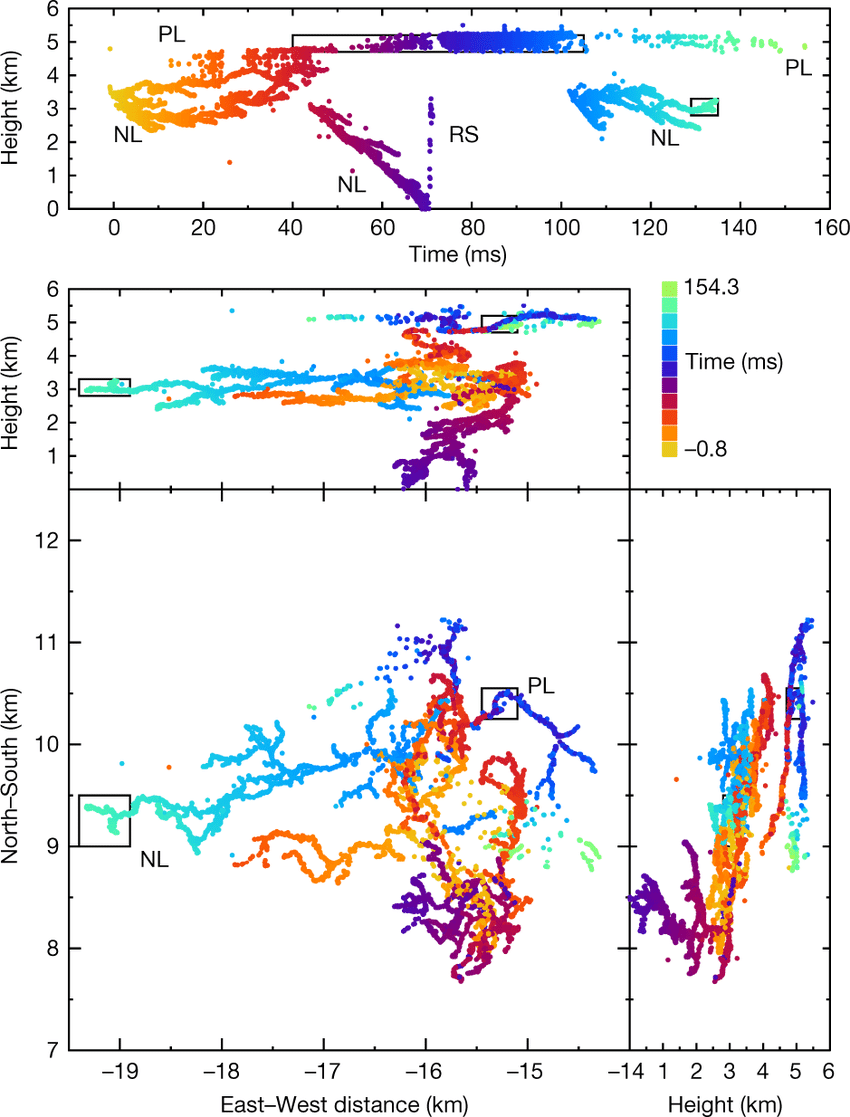Astronomy Object of the Month: 2018, September
< previous Archive next >
Needle-like structures on positively charged lightnings
Thunderbolts occuring in Earth’s atmosphere are dangerous yet still poorly understood natural
phenomenon. Typical lightning forms a network of plasma channels
propagating away from the initiation point with both positively and negatively charged ends—so-called positive and negative lightning leaders.
 Figure 1: Radio map of the lightning over the Netherlands from 2017. Each
dot represents a single radio detection. Detections associated with both positive (PL) and negative (NL) lightning leaders are shown. When the
negative leaders connects to Earth, it creates a "shortcut" that propagates upwards in the lightning channel and is sometimes called a return
stroke (RS). The distances on the map refer to the core of the LOFAR array. Credit: The Authors.
Figure 1: Radio map of the lightning over the Netherlands from 2017. Each
dot represents a single radio detection. Detections associated with both positive (PL) and negative (NL) lightning leaders are shown. When the
negative leaders connects to Earth, it creates a "shortcut" that propagates upwards in the lightning channel and is sometimes called a return
stroke (RS). The distances on the map refer to the core of the LOFAR array. Credit: The Authors.
Negative leaders propagate in discrete way. In the range from 30 to 300 megahertz, numerous radio pulses are observed. These pulses can be remotely sensed even from a distance, and imaged with high spatial and temporal resolution. On the other hand, positive lightning leaders propagate more continuously and emit low-power radiation at high frequencies. Despite this, their emission has been also detected. It turned out that this emission has a pattern that is different from that of negative leaders.
Moreover, researchers found that positive leaders can be temporarily disconnected from negative ones. However, this leads to the appearance of current pulses that again connect the positive and negative parts of lightning with each other. This implies many lightnings to occur between clouds and the Earth's surface.
It is believed that this disconnection process is due to negative differential resistance. This does not explain, however, why it occurs most often on positive leaders, or why the electric current in lightning directed from clouds to the surface never goes to zero. In addition, it is not known how the positive leader emits radio-frequency radiation and why it is different from the radiation of the negative leader in this respect.
Professor Marian Soida from the Astronomical Observatory of the Jagiellonian University belongs to the international team that recently presented crucial interferometric radio observations of lightning propagating over the Netherlands - with unprecedented time and spatial resolution in three dimensions. The work describing this research has recently appeared in Nature.
Obtaining these groundbreaking results was possible thanks to the data collected by the International LOFAR Telescope (ILT). LOFAR (LOw Frequency ARray) is an European network of antennas designed for observing the sky in the low radio frequency range. It is managed by the ASTRON research center located in the Netherlands. The LOFAR International Telescope consists of both antenna systems and other devices for observing, processing and storing data, located in several project member countries, including Poland, and managed under a joint scientific policy.
Based on observations with the LOFAR network, the team identified small plasma structures in lightning, which they called needles. Radio observations show that they are the dominant source of radio emission in the case of positive leaders. In addition, these structures appear to discharge the leaders, and are probably responsible for the process in which positive leaders disconnect from negative ones, and as a result, cloud-Earth (air-Earth) lightnings connect to the Earth's surface many times during an atmospheric discharge.
Original publication: Needle-like structures discovered on positively charged lightning branches, B. M. Hare et al., Nature (2019)
The research was conducted at the Department of Radioastronomy and Space Physics of the Jagiellonian University’s Astronomical Observatory (OAUJ).
The LOFAR cosmic ray key science project acknowledges funding from an Advanced Grant of the European Research Council (FP/2007–2013)/ERC Grant Agreement number 227610. The project has also received funding from the European Research Council (ERC) under the European Union’s Horizon 2020 research and innovation programme (grant agreement number 640130), and financial support from FOM (FOM-project 12PR304).
|
Marian Soida Astronomical Observatory Jagiellonian University Marian.Soida [at] uj.edu.pl |


